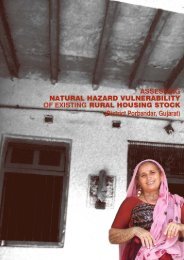Wastewater Irrigation in Gujarat - People in Centre Consulting
Wastewater Irrigation in Gujarat - People in Centre Consulting
Wastewater Irrigation in Gujarat - People in Centre Consulting
Create successful ePaper yourself
Turn your PDF publications into a flip-book with our unique Google optimized e-Paper software.
Out of 19 villages us<strong>in</strong>g wastewater for irrigation, 14 villages sow cotton on an<br />
average of 30 percent of total irrigated area. With assured supply of wastewater, BT<br />
cotton and high value crops like vegetables have <strong>in</strong>creased. Out of 5748 ha of gross<br />
area irrigated with wastewater, 2081 ha is under some or the other fodder crop. This<br />
is because fodder has high demand result<strong>in</strong>g from <strong>in</strong>creased milk demand <strong>in</strong> urban<br />
areas. <strong>Wastewater</strong> has high nutrient (nitrogen content), which <strong>in</strong>creases growth of<br />
the fodder crop significantly, and hence gives higher yields. Additionally, fodder<br />
cultivation is suitable for wastewater application. It requires cont<strong>in</strong>ual irrigation and is<br />
tolerant to detergents and other chemicals of cosmetics found <strong>in</strong> wastewater.<br />
However, <strong>in</strong> the use of wastewater for irrigat<strong>in</strong>g fodder, there is an <strong>in</strong>creased risk of<br />
heavy metals from <strong>in</strong>dustrial effluents gett<strong>in</strong>g mixed with domestic sewage enter<strong>in</strong>g<br />
human systems. Evidence of heavy metal transmission through milk is presented by<br />
Swarup et al. (1997). The other issue reported by few farmers <strong>in</strong> vic<strong>in</strong>ity of Vadodara<br />
city us<strong>in</strong>g wastewater for irrigation reported of compact<strong>in</strong>g and formation of crust on<br />
topsoil.<br />
Table 26: Net and Gross Area, Receipts and Cash Profit of <strong>Wastewater</strong> Irrigated<br />
Villages <strong>in</strong> Vadodara<br />
Village<br />
Net<br />
Irrigated<br />
Area <strong>in</strong><br />
Ha<br />
Net WW<br />
Irrigated<br />
Area <strong>in</strong> Ha<br />
Gross WW<br />
Irrigated Area<br />
<strong>in</strong> Ha<br />
Agriculture<br />
Receipts (Rs.<br />
<strong>in</strong> crore)<br />
Alamgir 518 433 823 6.91 3.63<br />
Chikhodra 242 137 137 0.45 0.18<br />
Gamdi 412 154 246 1.14 0.6<br />
Hussepur 286 143 143 1.25 0.72<br />
Itola(part) 373 142 156 0.88 0.54<br />
Kalali 196 98 156 0.96 0.35<br />
Karali 341 170 204 1.19 0.67<br />
Khalipur 408 408 734 3.03 1.62<br />
Khotwada 191 19 31 0.23 0.13<br />
Maretha 273 273 464 2.65 1.52<br />
Medhad 325 118 188 0.92 0.49<br />
Chasad(Part) 635 584 701 3.73 2.19<br />
Chapad<br />
(Part)<br />
293 235 375 2.69 1.55<br />
Silihor 350 175 230 1.06 0.66<br />
Talsat 109 77 86 0.52 0.33<br />
Tarsali 318 318 413 1.8 1.13<br />
Thekariya 126 88 114 0.48 0.29<br />
Vanarama 279 140 364 2.63 1.67<br />
Virpur 326 163 183 0.84 0.5<br />
Total 6001 3875 5748 33.33 18.78<br />
Source: Field study, 2012<br />
Cash<br />
Profit (Rs.<br />
<strong>in</strong> crore)<br />
45




